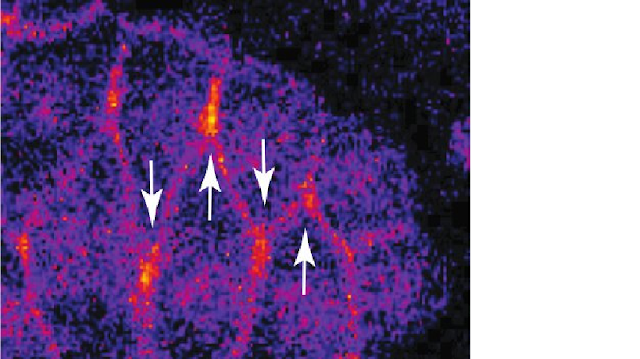Una proteina chiave indica la strada ai tessuti in sviluppo / A key protein marks the way for developing tissues
Una proteina chiave indica la strada ai tessuti in sviluppo / A key protein marks the way for developing tissues
Segnalato dal Dott. Giuseppe Cotellessa / Reported by Dr. Giuseppe Cotellessa
La termografia mostra l'attività della proteina CDC-42 in cellule cutanee di un embrione di C. elegans mentre stanno ordinatamente cambiando posizione, incuneandosi (frecce) nell'altro tessuto. I colori giallo e rosso indicano un'alta attività della proteina.
Thermography shows the activity of CDC-42 protein in skin cells of an C. elegans embryo while they are neatly changing positions, hagging (arrows) in the other tissue. Yellow and red colors indicate high protein activity.
E' stata individuata una proteina chiave che dirige i movimenti complessi e apparentemente caotici delle cellule nei tessuti embrionali in via di sviluppo. Si tratta di una proteina già nota perché permette alle cellule di distinguere il loro lato anteriore da quello posteriore e il sopra dal sotto.
Durante lo sviluppo embrionale il movimento apparentemente caotico delle cellule del tessuto cutaneo che serve a dargli la lunghezza e lo spessore corretto per ogni parte del corpo è orchestrato da una via di segnalazione che ha al suo centro una proteina, detta CDC-42 GTPasi. La scoperta è di un gruppo di ricercatori dell'Università del Wisconsin a Madison, che firmano un articolo pubblicato su “PLoS Genetics”.
Nell'embrione, i tessuti cambiano forma attraverso i cosiddetti movimenti di intercalazione, che possono essere molto complessi, per esempio come quello che permette a uno strato di tessuto di incunearsi fra strati vicini con l'effetto di comprimerlo in una direzione e stirarlo nell'altra.
Studi precedenti avevano suggerito che a dirigere questo tipo di movimenti ci fosse la proteina CDC-42, già nota per permettere alle cellule di distinguere il loro lato anteriore da quello posteriore e il sopra dal sotto.
Proprio per questa sua funzione essenziale nelle prime fasi dello sviluppo embrionale, tuttavia, studiare la proteina negli embrioni del modello animale è sempre stato problematico: anche piccole interferenze sperimentali con la sua funzionalità finivano per sovvertire l'intera architettura di base dell'embrione vanificando la possibilità di individuare eventuali funzioni “più fini” della CDC-42.
Nell'embrione, i tessuti cambiano forma attraverso i cosiddetti movimenti di intercalazione, che possono essere molto complessi, per esempio come quello che permette a uno strato di tessuto di incunearsi fra strati vicini con l'effetto di comprimerlo in una direzione e stirarlo nell'altra.
Studi precedenti avevano suggerito che a dirigere questo tipo di movimenti ci fosse la proteina CDC-42, già nota per permettere alle cellule di distinguere il loro lato anteriore da quello posteriore e il sopra dal sotto.
Proprio per questa sua funzione essenziale nelle prime fasi dello sviluppo embrionale, tuttavia, studiare la proteina negli embrioni del modello animale è sempre stato problematico: anche piccole interferenze sperimentali con la sua funzionalità finivano per sovvertire l'intera architettura di base dell'embrione vanificando la possibilità di individuare eventuali funzioni “più fini” della CDC-42.
Lavorando con un classico modello animale, il verme Chaenorhabditis elegans, Jeff Hardin e colleghi hanno ora trovato il modo per far esprimere una proteina CDC-42 sempre attiva solo ad alcune cellule - quelle del tessuto connettivo superficiale - e solo quando la temperatura ambiente supera una certa soglia.
In questo modo i ricercatori sono riusciti a dimostrare che la CDC-42 ha effettivamente un ruolo centrale
Il risultato, ricordano gli autori, va considerato valido sostanzialmente per tutto il mondo animale dato che la proteina in questione si è fortemente conservata in tutta la storia evolutiva, dal verme fino all'essere umano.
ENGLISH
A key protein has been identified that directs complex and apparently chaotic cells movements in developing embryonic tissues. It is a known protein because it allows cells to distinguish their front side from the back and the top from below.
During embryonic development, the apparently chaotic cellular tissue movement that serves to give it the correct length and thickness for each part of the body is orchestrated by a signaling path that has its core a protein, called CDC-42 GTPase. The discovery is a group of researchers from the University of Wisconsin in Madison, signing an article published on "PLoS Genetics".
In the embryo, the tissues change shape through the so-called intercalation movements, which can be very complex, for example, as allowing a layer of tissue to grow between adjacent layers with the effect of compressing it in one direction and stretching it in the " other.
Earlier studies suggested that to direct this type of movement there was the CDC-42 protein, already known to allow cells to distinguish their front from the back and from the underneath.
Precisely for this essential function in the early stages of embryonic development, however, studying protein in embryos of the animal model has always been problematic: even small experimental interferences with its functionality ended up subverting the entire basic embryo architecture by flailing the Possibility of detecting any "finer" functions of the CDC-42.
Working with a classic animal model, the Chaenorhabditis elegans worm Jeff Hardin and colleagues have now found ways to express a CDC-42 protein that is only active in some cells - those of the surface connective tissue - and only when the ambient temperature exceeds one Some threshold.
In this way, the researchers have been able to demonstrate that the CDC-42 has a central role
For the correct conformation of the tissues, also identifying other molecules that compete with that "ordered choreography" - as called Hardin - that brings these cells to their definite shape and position.
The result, the authors say, is considered to be valid throughout the animal world as the protein in question has been strongly conserved throughout evolutionary history, from worm to human being.
Da:
http://www.lescienze.it/news/2016/11/22/news/sviluppo_forma_tessuti_embrione_cdc-42-3317089/




Commenti
Posta un commento